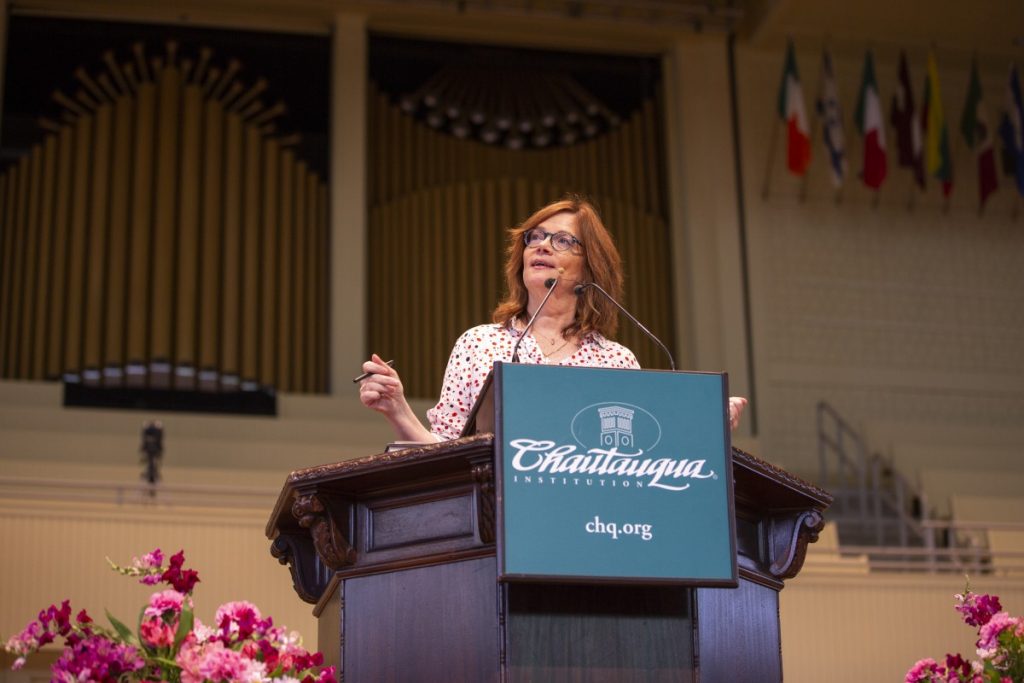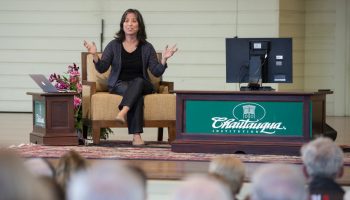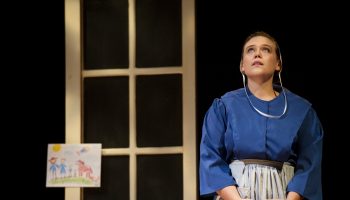
When Ann Hornaday moved to New York City in the 1980s to pursue writing — against the grain of her political science and government college education — movie media coverage was coming to the fore.
Breakout documentaries like “The Thin Blue Line,” a true-crime tale with revolutionary reenactments and stylized visuals, and “Roger & Me,” a personal, provocative piece about Flint, Michigan’s relationship to General Motors, rocked “canonizers” and tastemakers.
“These all came out within a few years of each other,” Hornaday said. “In a way, each of them distills traditions in documentary filmmaking that reach back to the beginnings of the form, but they also point a way forward. And they very much ushered in — what I still consider — a golden age of documentaries.”
The work of late 20th-century documentaries boosted the current “golden age of documentaries” while galvanizing Hornaday’s career as a film critic — a career spanning four decades and 1,500 movies.
Prior to her tenure as a film critic at The Washington Post, Hornaday began as a researcher and editorial assistant at Ms. magazine, quickly transitioning to a freelance writer. She eventually went on to write for The New York Times Arts & Leisure section, later writing for the Austin American-Statesman in Austin, Texas, and then The Baltimore Sun; she was a finalist for the 2008 Pulitzer Prize in criticism.
Hornaday is also the author of Talking Pictures: How to Watch Movies. She spoke to the history of documentaries and the role of the audience in critically evaluating their messages at Wednesday’s 10:45 a.m. morning lecture in the Amphitheater. Her lecture continued Week Nine’s theme, “Documentary Film as Facilitator: Storytelling, Influence and Civil Discourse.”
Documentaries were the genesis of film, she said; motion captured with the early versions of the camera featured everyday activities, like people chatting in yards and trains departing from stations, in short, sparse videos. More advanced 20th-century documentaries went down like “spinach,” Hornaday said, for the children who grew up watching them.
“It was usually some sort of stock footage, usually narrated by a guy — a white guy — very authoritative, a little bit droning,” she said. “It was boring; it was bland. … It was good for you, but you’re not going to like it very much.”
But that changed with Ken Burns’ “The Civil War.” It was still a hodgepodge of archival footage, authoritative narration, unexciting and static visuals, Hornaday said; but the combination of editing, writing and music elevated the traditional, educational, historical documentary to a must-see spectacle — “they’re not spinach anymore; they probably never were,” she said.
With the increasing allure of film festivals and the onset of streaming services, documentaries are trending, according to Hornaday. HBO pioneered widely accessible documentaries, followed by Netflix, Amazon and cable networks that have recently dedicated airtime to network-produced documentary programs. In the mainstream, “RGB” and “Won’t You Be My Neighbor?” are taking box offices by storm, she said while taking a “ceremonial sip” of water for Supreme Court Justice Ruth Bader Ginsburg.
Also in high demand is another facet of documentary work: reality television. Through one lens, Hornaday said, reality TV is voyeurism, a human zoo.
“To put another lens on it, it’s this interest we have in each other’s lives and in each other’s behavior,” Hornaday said. “It’s a form of moral reasoning, if you will. It’s a way for us to grapple with our own values, our own judgement. It might be invidious, it might be critical, it might be negative, but it’s all a way of situating ourselves in terms of what we believe, of what we think is right and wrong. So even the most silly and stagy and tacky reality programming, I do think — I would like to think — fulfills a deeper moral purpose.”
While “The Bachelor,” “Keeping Up with the Kardashians” and “Big Brother” are notorious for being scripted-ly unscripted, Hornaday stressed the importance of not taking presented truths at face value, referencing Robert Flaherty’s “Nanook of the North” as the “first cautionary tale.”
“Nanook of the North” is an early 20th-century docudrama about Nanook, an Inuk man, and his family in the Canadian Arctic. Though it was widely revered as the first feature-length documentary, it was later revealed that Flaherty staged scenes to depict stereotypical, obsolete practices of the Inuk people.
“Because documentaries have become so much more visually sophisticated,” Hornaday said, “and because those reality show producers are evermore shrewd about blurring the lines between fact and fiction, it’s more crucial than ever for viewers to be as critically discerning as they can be about what they are watching.”
If its characters are compelling, the story is riveting, the information imparts alarming or astounding or inspiring material — let that immersion happen. But when the spell is lifted, remember: you might have gotten the facts, but you were looking at art.”
Hornaday pulled three evaluative questions from her book, Talking Pictures, for movie audiences to contemplate: what was the filmmaker trying to achieve, did they achieve it and was it worth making?
“Formal questions of what to put in and what to leave out in editing immediately lead to ethical ones when it comes to issues such as access, agendas and transparency,” she read from her book. “Did the filmmakers use reenactments along with historical footage to make their film more seamless and compelling? Did they use images from another time and place because they fit their uses better? Did they compensate their subjects, or were they compensated by their subjects while making the film?”
Despite the similarities and the parallels drawn between the two mediums, Hornaday does not see the documentary as the “new journalism.” To her, equating documentaries with journalism is alarming; she seeks to preserve documentaries as an art form — as a form of storytelling.
“They are a form of conveying a narrative and of making meaning that are deeply dependent on anecdotes. They are dependent on and expressions of one artist’s point of view,” Hornaday said. “There is a level of craft and shaping of the narrative that, in my mind, exceeds the boundaries of what we think of when we think of journalism.”
However, similar to journalism, she sees the next frontier for documentaries as “transparency” — directors letting viewers in on their processes, noting staged scenes, forged photographs or fudged footage. Such transparency, she said, would strengthen the bond between viewer and videographer.
Hornaday closed with a “how to” on watching documentaries:
“Succumb, to let it wash over you. If its characters are compelling, the story is riveting, the information imparts alarming or astounding or inspiring material — let that immersion happen. But when the spell is lifted, remember: you might have gotten the facts, but you were looking at art.”
After the conclusion of Hornaday’s lecture, Geof Follansbee, vice president of development and chief executive officer of the Chautauqua Foundation, opened the Q-and-A by asking what the line is between documentaries and fact-based fiction.
“As these filmmakers are getting more bold about mixing it up, that line is going to be blurry,” Hornaday said. “Again, I think it’s up to the filmmaker to be transparent about that.”
Follansbee then turned to the audience for questions; one attendee asked Hornaday to comment on the inherent bias of documentaries.
“To the degree that they have a point of view, yes,” Hornaday said. “That’s my point about art — they are the work of artists, and artists have a point of view. They will reflect that personal point of view of whoever is making it. Then the question is … ‘How does the filmmaker use that power and how are they then transparent about that bias?’ ”
To close, Follansbee read a question from Twitter: How does one stay true to themselves and find commercial success?
“I don’t think you can manufacture that,” Hornaday said “ … I think ‘stay true to yourself’ is the best thing because if you’re going to be living with this subject matter for goodness knows how many years, you’d better love it and believe in it and then really hope it connects with an audience.”




